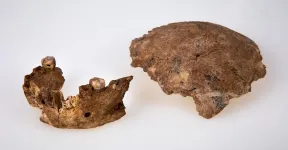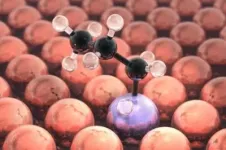(Press-News.org) Parents of children with the most complex medical conditions are more likely to report poor or fair mental health and struggle to find community help, according to a study completed by researchers at University of Rochester Medical Center (URMC) and Golisano Children's Hospital. The study was published in Pediatrics, the journal of the American Academy of Pediatrics (AAP).
The study, "A National Mental Health Profile of Parents of Children with Medical Complexity," examined parent-reported data from the National Survey of Children's Health, and compared three groups: households of children with medical complexity (CMC), households of noncomplex children with special health care needs, and households of children without special health care needs.
CMC are defined as the 1 percent of children with the most complex medical conditions. They tend to have multiple chronic health conditions and disabilities, and frequently utilize health care services. Examples of CMC include those with cerebral palsy, serious congenital heart defects, or genetic disorders. Given these children's significant needs, their caregivers are challenged to balance treating their child with completing other family responsibilities.
The study found the following:
-About 20 percent of parents of CMC reported poor or fair mental health, more than 5 times the proportion of parents of children who did not have medical problems.
-In addition, 36 percent of parents of CMC reported not knowing where to go for help in their community when they encounter difficulties, which was more than 2 times the proportion of parents of children who did not have medical problems.
These findings indicate that health care systems should be proactive in trying to serve parents of CMC and provide support resources, and that mental health should be prioritized, according to Nathaniel Bayer, M.D., assistant professor and pediatric hospitalist at Golisano Children's Hospital in the URMC Department of Pediatrics and lead author of the study.
"As we partner with these families, we need to make sure we're taking care of the parents as well as the children," said Bayer, "It is our job as pediatricians and health care teams to recognize the parents' needs and connect them to services."
Only 15 percent of parents of CMC reported access to peer support groups, which are critical for families to be able to exchange ideas and support each other, according to Bayer. To help address these gaps, hospitals should offer peer-to-peer support groups and grow family advisory councils to support the health and emotional wellness of caregivers of CMC.
"Having a child with this level of needs affects families in so many different ways. With the right support, these families thrive and fulfill their goals," said Bayer. "Without enough support, these families often struggle with the emotional and physical demands of constant caregiving, financial stressors, and employment issues. They may also be unable to find assistance from community services and home nurses, which are under-funded and under-reimbursed."
Research on families and parents of CMC is an emerging field, because kids with complex conditions are living longer as healthcare interventions have improved in the 21st century. "In the last decade, there's a heightened interest in discussing and focusing on these children and their families because we are increasingly recognizing that they need more support to successfully navigate the complicated health, education, and community systems."
The study also found that families of lower socio-economic status (SES) reported feeling significantly more isolated and unaware of how to seek support. "Families of lower SES often do not have the resources to easily access services. They may lack the transportation to travel to the clinic or struggle to find community resources in their area. If your family is also struggling to put food on the table or keep the lights on, it's harder to manage your child's medical needs and take care of yourself," said Bayer.
In addition to health care systems providing more peer-to-peer services, more federal and state support of CMC parents - including greater reimbursement for home-health services and caregivers, expanded services and access for kids with disabilities, and improved early intervention support - can all help parents of CMC, according to Bayer. Behavioral health and wellness services - both for children and parents - should also be expanded.
"Mental health is a part of health," said Bayer, "Parent and caregiver mental health is a major issue that has a significant impact on children's health. We need to talk more about parent mental health, screen for it more, and proactively support it."
Bayer and his research team plans to continue studying the mental health of CMC parents, the resilience of their families, and their abilities to adapt to challenges. The team is currently surveying and interviewing local families of CMC in the Rochester region to examine these topics. After studying how resilience and emotional wellness develop in families of children with complex medical conditions, he is planning to build family support programs and study their impact on child and caregiver health.
INFORMATION:
Additional study co-authors include Justin Yu, M.D., M.S. of University of Pittsburgh; Dennis Kuo, M.D., M.H.S. of University at Buffalo; and Hongyue Wang, Ph.D., Jill Halterman, M.D., M.P.H., and Yue Li, Ph.D. of URMC.
Not all stresses are created equal, according to a pair of new studies, which shows that distinct ubiquitination patterns underlie cell recovery following different environmental stressors. Eukaryotic cells respond to environmental stressors - such as temperature extremes, exposure to toxins or damage, for example - through adaptive programs that help to ensure their survival, including the shutdown of key cellular processes. These responses are often associated with the formation of stress granules (SGs) - dense cytoplasmic aggregations of proteins and RNA - as well as with ...
Although the Antibody Mediated Prevention (AMP) study that launched in 2016 failed to show significant efficacy in a pair of clinical trials, Denis Burton argues in a Perspective that the AMP study's results represent a landmark in AIDS research; they show - for the first time - that a broadly neutralizing antibody (bnAb) can protect humans against exposure to some strains of HIV. According to Burton, the AMP study's data - despite not showing a significant difference between the numbers of infected individuals in the treated groups versus those in the placebo groups - still have tremendous implications for future HIV vaccine design and passive bnAb use strategies. The AMP study evaluated the immunotherapeutic ...
BINGHAMTON, N.Y. -- Analysis of recently discovered fossils found in Israel suggest that interactions between different human species were more complex than previously believed, according to a team of researchers including Binghamton University anthropology professor Rolf Quam.
The research team, led by Israel Hershkovitz from Tel Aviv University, published their findings in Science, describing recently discovered fossils from the site of Nesher Ramla in Israel. The Nesher Ramla site dates to about 120,000-140,000 years ago, towards the very end of the Middle Pleistocene time period.
The human fossils were found by Dr. Zaidner of ...
Researchers at Tufts University, University College London (UCL), Cambridge University and University of California at Santa Barbara have demonstrated that a catalyst can indeed be an agent of change. In a study published today in Science, they used quantum chemical simulations run on supercomputers to predict a new catalyst architecture as well as its interactions with certain chemicals, and demonstrated in practice its ability to produce propylene - currently in short supply - which is critically needed in the manufacture of plastics, fabrics and other chemicals. The improvements have potential for highly efficient, "greener" chemistry with a lower carbon footprint.
The demand for propylene is ...
The discovery of a new Homo group in this region, which resembles Pre-Neanderthal populations in Europe, challenges the prevailing hypothesis that Neanderthals originated from Europe, suggesting that at least some of the Neanderthals' ancestors actually came from the Levant.
The new finding suggests that two types of Homo groups lived side by side in the Levant for more than 100,000 years (200-100,000 years ago), sharing knowledge and tool technologies: the Nesher Ramla people who lived in the region from around 400,000 years ago, and the Homo sapiens who arrived later, some 200,000 years ago.
The new discovery also gives clues about a mystery in human evolution: How did genes of Homo sapiens penetrate the Neanderthal population that had presumably lived in Europe long before ...
Mythological nymphs reincarnate as a group of corn smut proteins to launch a battle on maize immunity. One of these proteins appears to stand out among its sister Pleiades, much like its namesake character in Greek mythology. The research carried out at GMI - Gregor Mendel Institute of Molecular Plant Biology of the Austrian Academy of Sciences - is published in the journal PLOS Pathogens.
Pathogenic organisms exist under various forms and use diverse strategies to survive and multiply at the expense of their hosts. Some of these pathogens are termed "biotrophic", as they are parasites that maintain their hosts alive. These biotrophic pathogens deregulate physiological processes in their hosts by suppressing their immune defenses and favoring disease development. ...
INDIANAPOLIS -- A first-of-its-kind large-scale study of vegetation growth in the Northern Hemisphere over the past 30 years has found that vegetation is becoming increasingly water-limited as global temperatures increase.
The results are significant since vegetation is one of the biggest factors when it comes to controlling water and carbon cycling across Earth, which influences global temperatures. The work by IUPUI and Indiana University Bloomington researchers Wenzhe Jiao, END ...
(Denver)-Patients with primary lung cancer detected using low-dose computed tomography screening are at reduced risk of developing brain metastases after diagnosis, according to a study published in the Journal of Thoracic Oncology.
JTO is an official journal of the International Association for the Study of Lung Cancer. The full study is available here: Impact of Low-Dose Computed Tomography Screening for Primary Lung Cancer on Subsequent Risk of Brain Metastasis - Journal of Thoracic Oncology (jto.org)
The researchers, led by Summer Han, PhD, from Stanford University School of Medicine in Palo ...
A new research paper published in the American Journal of Clinical Nutrition last week showed that a low Omega-3 Index is just as powerful in predicting early death as smoking. This landmark finding is rooted in data pulled and analyzed from the Framingham study, one of the longest running studies in the world.
The Framingham Heart Study provided unique insights into cardiovascular disease (CVD) risk factors and led to the development of the Framingham Risk Score based on eight baseline standard risk factors--age, sex, smoking, hypertension treatment, diabetes status, systolic blood pressure, total cholesterol (TC), and HDL cholesterol.
CVD is still the leading cause of death globally, and risk can be reduced by changing behavioral factors such as unhealthy diet, ...
A new technique to look at tumors under the microscope has revealed the cellular make-up of Wilm's tumors, a childhood kidney cancer, in unprecedented detail. This new approach could help understand how tumors develop and grow, and fuel research into new treatments for children's cancers.
Scientists at the Princess Máxima Center for pediatric oncology developed a new imaging technique and computational pipeline to study millions of cells in 3D tissue, revealing hundreds of features from each individual cell. Their research was published this month in Nature Biotechnology.
By offering a look at individual cells within an intact organ, the new technique helps scientists analyze the molecular profile of the cells, as well as their ...




